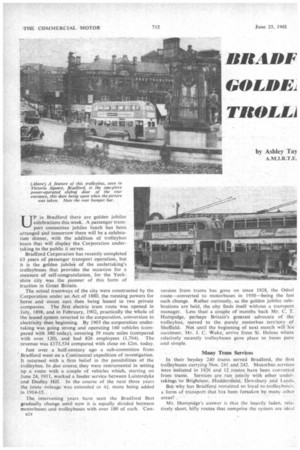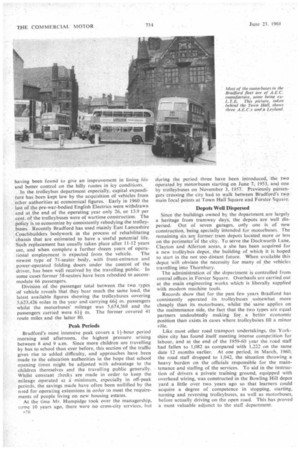BRAM P'S GOLDK TROLL USES
Page 58

Page 59

Page 60

If you've noticed an error in this article please click here to report it so we can fix it.
Yorkshire Town's Loyalty to Trolleybuses is Mainly Due to Short, Heavilyladen Hilly Routes: Biggest Surplus from Trolleys in Fleet Split Equally Between Electric and Motor Traction
by Ashley Tay
A.M.I.R.T.E.
UP in Bradford there are golden jubilee celebrations this week. A passenger transport committee jubilee lunch has been arranged and tomorrow there will be a celebration dinner, with the addition of trolleybus tours that will display the Corporation under
taking to the public it serves.
Bradford Corporation has recently completed 63 years of passenger transport operation, but it is the golden jubilee of the undertaking's trolleybuses that provides the occasion for a measure of self-congratulation, for the Yorkshire city was the pioneer of this form of traction in Great Britain.
The actual tramways of the city were constructed by the
Corporation under an Act of 1880, the running powers for horse and steam cars then being leased to two private companies. The first electric tram route was opened in July, 1898, and in February, 1902, practically the whole of the leased system reverted to the corporation, conversion to electricity then beginning. By 1903 the corporation undertaking was going strong and operating 160 vehicles (com
pared with 380 today), covering 39 route miles (compared with over 120), and had 826 employees (1,794). The revenue was £173,534 compared with close on £2m. today.
Just over a half-century ago a sub-committee from Bradford went on a Continental expedition of investigation. It returned with a firm belief in the possibilities of the trolleybus. In due course they were instrumental in setting up a route with a couple of vehicles which, starting on June 24, 1911, worked a feeder service between Laisterdyke and Dudley Hill. In the course of the next three years the route mileage was extended to 4:3c, more being added
in 1914-15. .
The intervening years have seen the Bradford fleet gradually change until now it is equally divided between motorbuses and trolleybuses with over 180 of each. Cona24 version from trams has gone on since 1928, the Odsal route—converted to motorbuses in 1950—being the last such change. Rather curiously, as the golden jubilee celebrations are held, the city finds itself without a transport manager. Less than a couple of mo.nths back Mr. C. T. Humpidge, perhaps• Britain's greatest advocate of the trolleybus, moved to the purely motorbus territory of Sheffield. Not until the beginning of next month will his successor, Mr. J. C. Wake, arrive from St. Helens where relatively recently trolleybuses gave place to buses pure and simple.
Many Tram Services
In their heyday 240 trams served Bradford, the first trolleybuses carrying Nos. 241 and 242. Motorbtis services were initiated in 1926 and 12 routes have been converted from trams. Services are run jointly with other undertakings to Brighouse, Huddersfield. Dewsbury and Leeds.
But why has Bradford remained so loyal.to-trollevbtiws. a form of transport that has been forsaken by man) other areas?
Mr. Humpidge's answer is that the heavily laden, relatively short, hilly routes that comprise the system are ideal for this vehicle. In the 1959-60 year, the last period for which complete figures are available, the gross surplus of the undertaking was £182,663, of which £96,627 arose from trolleybus operation and £86,036 from motorbuses.
For the first time for eight years the number of passengers had not decreased and normally a tricful net surplus would have been shown. But acceleration of debt redemption resulted in there being a deficiency of £73,849 to be made good by the rate fund. On the credit side is the fact that, by the continuance of the policy mentioned, the then outstanding loan of £259,000 on buildings, vehicles and overhead equipment might well be liquidated in the fairly, near future. To achieve this Bradford Corporation transport committee have been rationing themselves in the acquisition of new vehicles. Incidentally, a useful saving of well over £21.000 resulted from the cut in excise duty on buses.
Initial Progress
To go back to the beginning, prior to thc 1914-18 war. the progress of the city's first trolleybuses encouraged those responsible for, them to procure more vehicles and to run them on a lightly loaded service between Canal Road and the city centre. Then came the upheaval of the Great War and, although there had been a radial trolleybus extensicn of a tram route, it was not until about 1928 that the decision was taken to convert a further route to trolleys, and ultimately to change over all the tram services in the city. The Wibscy service trams went out during the time of the second war, motorbuses taking over, later to he replaced by trolleys. ,
Originally the fleet was mainly of A.E.C. and English Electric manufacture, but the Karrier clement grew during the 1939-45 period and the trolleybus section now includes A.E.C., Sunbeam, Karricr and B.U.T. units whilst the motorbuses are mainly A.E.C. with a few Leylands. As mentioned earlier, the transport elders of Bradford are rather committed to a canny policy in relation to vehicle purchase. An example of their careful approach was the acquisition in the 1958-59 year of 25 ex-London A.E.C. RT-type vehicles, which were employed as replacements for 27 wartime Daimlers. The following year, however, they went in for 15 A.E.C. Regent buses with M,C.W.Weymann front-entrance bodies having seating for 70 passengers.
Bradford has accepted the exhaust brake for buses, it e25 having been found to give an improvement in lining life and better control on the hilly routes in icy conditions.
In the trolleybus department especially, capital expenditure has been kept low by the acquisition of vehicles from other authorities at economical figures. Early in 1960 the last of the pre-war-bodied English Electrics were withdrawn and at the end of the operating year only 26, or 13.9 per cent, of the trolleybuses were of wartime construction. The policy is to economize by consistently rebodying the trolleybuses. Recently Bradford has used mainly East Lancashire Coachbuilders bodywork in the process of rehabilitating chassis that are estimated to have a useful potential life. Such replacement has usually taken place after 11-12 years use, and when complete a further dozen years of opera
tional employment is expected from the vehicle. The newest type of 71-seater body, with front-entrance and power-operated -folding doors under the control of the driver, has been well received by the travelling public. In some cases former 58-seaters have been rebodied to accommodate 66 passengers.
Division of the passenger total between the two types of vehicle reveals that they bear much the same load, the latest available figures showing the trolleybuses covering 5.623,426 miles in the year and carrying 66.; m. passengers whilst the motorbuses' mileage was 5,674,368 and the passengers carried were 61f m. The former covered 41 route mites and the latter 80.
Peak Periods
Bradford's most intensive peak covers a 14-hour period morning and afternoon, the highest pressure arising between 8 and 9 a.m. Since more children are travelling by bus to school than ever before, this section of the traffic 'gives rise to added difficulty, and approaches have been made to the education authorities in the hope that school opening times might be adjusted with advantage to the children themselves and the travelling public generally. Whilst constant :heck; are made in order to keep the mileage operated at a minimum, especially in off-peak periods, the savings made have often been nullified by the need for operating extensions in order to meet the requirements of people living on new housing estates.
At the time Mr. Humpidge took over the managership, come 10 years ago, there were no cross-city services, but during the period three have been introduced, the two operated, by motorbuses starting on June 7, 1953, and one by trolleybuses on November 3, 1957. Previously passengers crossing the city had to walk between Bradford's two main focal points at Town Hall Square and Forster Square.
Depots Well Dispersed Since the buildings owned by the department are largely a heritage from tramway days, the depots are well dispersed. Out of seven garages, only one is of new construction, being specially intended for motorbuses. The remaining six are former tram depots located more or less on the perimetersOf the city. To serve the Duckworth Lane, Clayton and Allerton areas, a site has been acquired for a new trolleybUs depot, the building of which it is hoped to start in the not too distant future. When available this depot will obviate the necessity for many of the vehicles travelling into Thornbury.
The administration of the department is controlled from central offices in Forster Square. Overhauls are carried out at the main engineering works which is liberally supplied with modern machine tools.
Records show that for the past few years Bradford has consistently operated its trolleybuses somewhat more cheaply than its motorbuses, whilst the same applies on the maintenance side, the fact that the two types are equal partners undoubtedly making for a better economic position than exists in cases where trolleybuses lill a minor role.
Like most other road transport undertakings, the Yorkshire city has found itself meeting intense competition for labour, and at the end of the 1959-60 year the road staff had fallen to 1,082 as compared with 1,222 on the same date 12 months earlier. At one period, in March, 1960, the road staff dropped to 1,042, the situation throwing a heavy burden on the officials responsible for the maintenance and staffing of the services. To aid in the instruction of drivers a private training ground, equipped with overhead wiring, was constructed in the Bowling Hill depot yard a little over two years ago so that learners could acquire a degree of competence in stopping, starting. turning and reversing trolleybuses, as well as motorbuses, before actually driving on the open road. This has proved a most valuable adjunct to the staff department.




















































































































